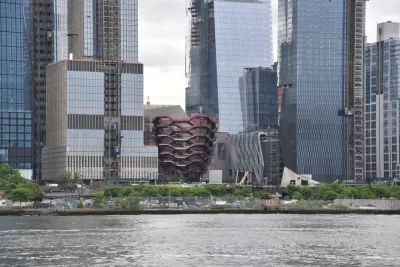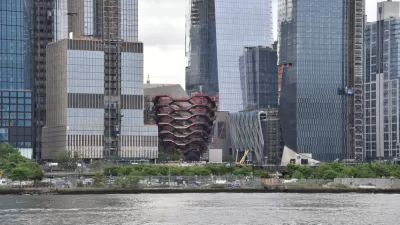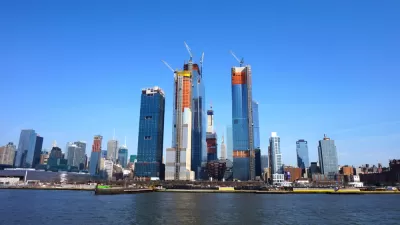The size and scale of Hudson Yards in the skyline of Manhattan will match the size and scale of public and private investment in the project. The project's effect in the city's economy will be just as conspicuous.

Greg David says there's a big angle to the story about the Hudson Yards project in New York City that is going unnoticed amidst a dispute between unions and developer The Related Cos.
The bigger story is the way Hudson Yards has—faster than anyone expected—fulfilled the two goals of the government officials who set it in motion: create capacity for the New York economy to expand and revive a moribund waterfront section of Manhattan. Its success can be attributed to more than $600 million in direct public investment and a very lucrative tax break.
The first phase of Hudson Yards, built with more than $18 billion in equity and debt over a storage and maintenance yard for Long Island Rail Road trains, will open to the public next March 14, Related says. The numbers couldn't be more impressive. The developer has leased or sold 7 million square feet of office space to tenants ranging from luxury accessories specialist Tapestry to ad agency BCG to media giant Time Warner to BlackRock, the largest money manager in the world. Some 55,000 thousand people will work there every day.
The article includes a history of the project, from its early days as a cornerstone in the Bloomberg Administration's pitch to bring the Olympics to New York City in 2012 (the games were ultimately played in London) to the big public investments that have set the stage for the success of Hudson Yards.
FULL STORY: The story of Hudson Yards is now the story of New York

Planetizen Federal Action Tracker
A weekly monitor of how Trump’s orders and actions are impacting planners and planning in America.

San Francisco's School District Spent $105M To Build Affordable Housing for Teachers — And That's Just the Beginning
SFUSD joins a growing list of school districts using their land holdings to address housing affordability challenges faced by their own employees.

The Tiny, Adorable $7,000 Car Turning Japan Onto EVs
The single seat Mibot charges from a regular plug as quickly as an iPad, and is about half the price of an average EV.

Seattle's Plan for Adopting Driverless Cars
Equity, safety, accessibility and affordability are front of mind as the city prepares for robotaxis and other autonomous vehicles.

As Trump Phases Out FEMA, Is It Time to Flee the Floodplains?
With less federal funding available for disaster relief efforts, the need to relocate at-risk communities is more urgent than ever.

With Protected Lanes, 460% More People Commute by Bike
For those needing more ammo, more data proving what we already knew is here.
Urban Design for Planners 1: Software Tools
This six-course series explores essential urban design concepts using open source software and equips planners with the tools they need to participate fully in the urban design process.
Planning for Universal Design
Learn the tools for implementing Universal Design in planning regulations.
Smith Gee Studio
City of Charlotte
City of Camden Redevelopment Agency
City of Astoria
Transportation Research & Education Center (TREC) at Portland State University
US High Speed Rail Association
City of Camden Redevelopment Agency
Municipality of Princeton (NJ)





























